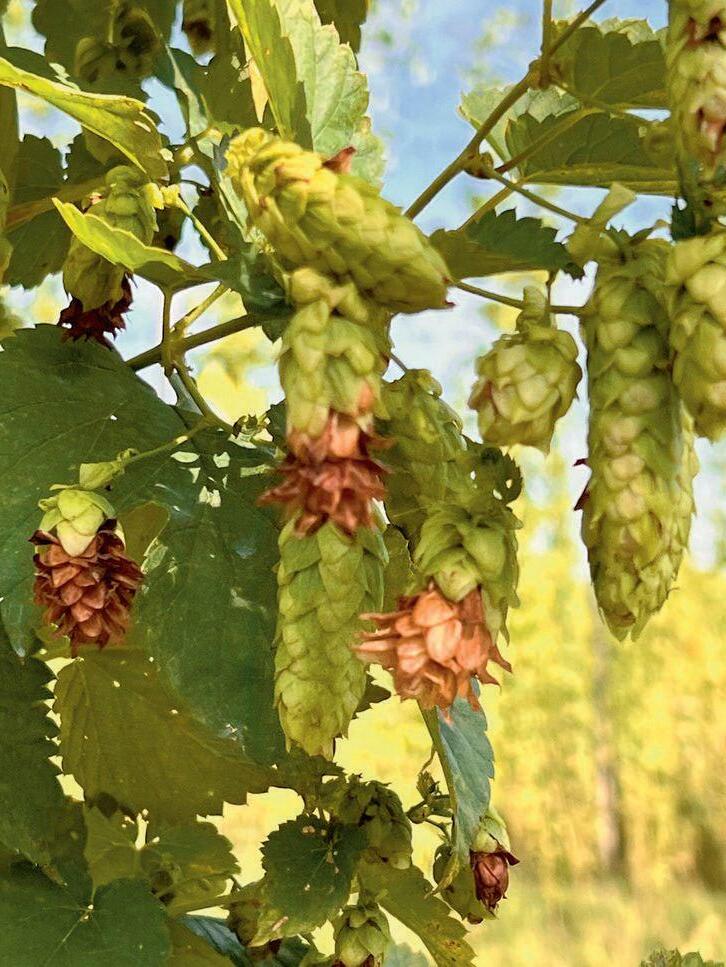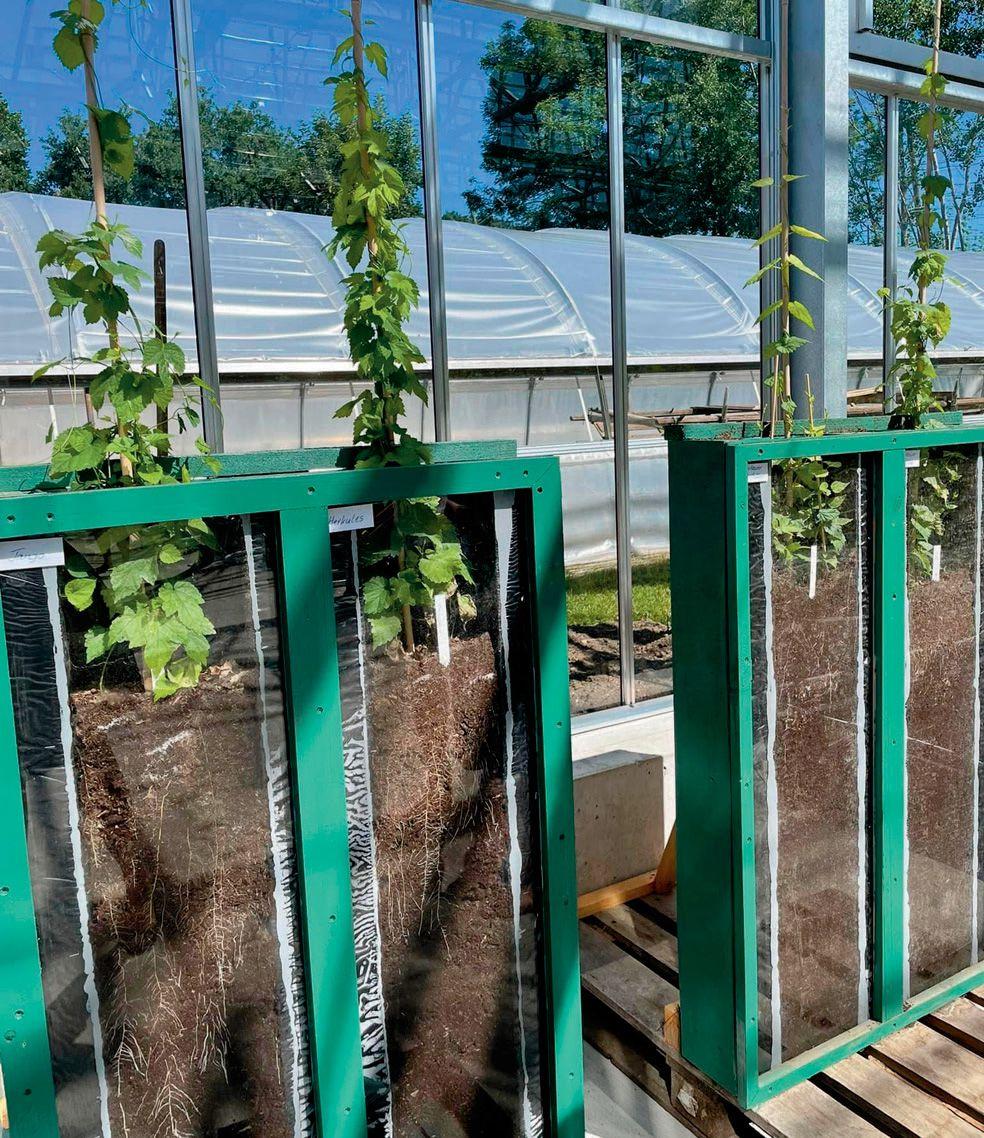
Editor’s Note:
isisthesecondinaseriesofbrewingandclimate change articles that will appear in e New Brewer


Editor’s Note:
isisthesecondinaseriesofbrewingandclimate change articles that will appear in e New Brewer

BY HORST DORNBUSCH & WALTER KÖNIG
In the January/February 2025 issue of e New Brewer, Part 1 of the Brewing & Climate Change series provided a broad overviewoftheforcesthatdriveclimate change—especially the world’s often-overlooked ocean currents—and the resulting effects on weather patterns in the key hop and barleycultivationregionsaroundtheglobe.
Part 2 focuses more narrowly on the characteristics of the hop plant (Humulus lupulus) that make it highly susceptible to climate-inducedenvironmentalchanges,as well as on the key measures currently underway to ensure the long-term survival of diverse hop varieties for the future.

As a species, the hop plant originated in western Asia and eastern Europe, then spread and diversied across the temperate zonesoftheNorthernHemisphere. us, with few exceptions, the primary genetic sources of all the world’s modern hops are the six landraces of Central Europe— CzechSaaz;GermanSpalter,Hersbrucker, Tettnanger, and Hallertauer Mittelfrüh; and French Strisselspalt. e key to their unique avors and aromas, often described as“noble,”istheircenturies-old,evolutionary-adaptive, terroir-specic, and eventually stable feedback interrelationship between what these plants need and what they get



But climate change is now tearing that well-establishedbalanceasunder.Often,the eect is a great variation in yield and quality of the same variety from year to year and region to region. is uctuation greatly impactstheeconomicviabilityoftheentire hop value chain, from growers and processors to distributors and brewers—and therein lies the new challenge that all hop breedersaroundtheglobefacetoday.
e hop plant is one of the most demandingcommercialcropsonearth,butalsoone of the most astonishing performers. Because its ideal vegetation cycle requires a seasonal variation in high-intensity daylight, fromalmostninehoursduringtheshortest day of the year—the winter solstice in the Northern Hemisphere—to roughly 15 hours during the longest day—the summer solstice—itthrivesonlybetweenlatitudes 35 to 55 in the northern half of the globe and latitudes 35 to 45 in the southern half. Along the equator, by comparison, where bothnightanddayare12hourslongall year round, hops cannot survive.
Each spring, as the days lengthen, the vernalizing rhizomes “wake up” and send their shootsthroughthesoil,and,underoptimal environmental conditions, these new plants burst into an incredible growth spurt of up to 12 inches (30 cm) a day between May andJune(intheNorthernHemisphere).
is perennial climbing bine is one of the fastest growing plants on earth. Most hop
varieties reach a nal height of 20 to 26 feet(6to8meters),althoughdwarfhops specically bred to grow on low trellises or in hedgerow systems only reach a height of about 8 to 10 feet (2.5 to 3 meters).
Asthegrowingseasonmovesintoearly summer, climatic factors continue to steer the plants’ physiological processes. ese include their rate of vegetative growth, the timingoftheir owering,thechemicalformation of their compounds, and ultimately, their cone quality and yield per acre. As the number of daylight hours approaches the15-hourmarkandasambienttemperatures rise, hop bines grow strong horizontal branches that will later hold the cones. At the same time, they develop stable root systemsthatsupplysucientwaterandrequired nutrients. e length and intensity of daylight also controls the plants’ energy-producing photosynthesis and overall biomassdevelopment. is,inturn,determines the vigor, health, and density of their branches and canopy of leaves. After the summer solstice, as the days shorten, hop plantsswitchfromtheirvegetativetotheir generative (owering) phase, when they start to put all their energy into the formation of cones and the production of various acidsandoilsinthelupulinglands.

However, stress factors can interfere with this normal growth pattern. For example, severe droughts or prolonged temperatures above85°F(29°C)earlyinthegrowingseason can cause premature owering and lower harvest yields, thus reducing the overall


protability of the crop. Likewise, too many overcastorrainydaysinlatesummerwith less sunshine can delay the critical development of cones and their compounds.
Hops also require a stable and tightly denedsupplyofwater,whichamountsto about 27.5 to 40 inches (700 to 1,000 mm) of rain and/or irrigation annually, most of which is needed during the growth period. Especiallyduringconeformation,aconsistent and ample supply of water is crucial for both yield and quality. For this regimen, hops also prefer permeable soils with sucient water retention and a neutral to slightly acidic pH of 6 to 7; and soil nitrogen and potassium are essential for growth and the formation of acids. erefore, soils that are poor in nutrients, are poorly drained, or, conversely, are waterlogged can weaken the root system and negatively impact plant health and crop yields.
In real estate, the saying goes that the three most important variables dening a property’s value are “location, location, location.” e same axiom may also apply to hop growing because the location of hop gardens determines the hours of daily sunshine and thus the length of the plants’ vegetation period. In such German landrace growing centers as the Hallertau and Tettnang, for instance (see Part 1), hop plants benet from both the temperate climate and the long days of summer, which promote plant growth and cone quality. In otherareas of the world, such as Tasmania and Victoria, Australia and Nelson, New Zealand, summer days are shorter, and the varieties planted there have adapted to these conditions. is is one of the reasons why it is usually dicult to swap varieties among dierent terroirs.
Hops generally prefer locations with average growing season temperatures between 60 and 75°F (16 to 25°C), which are typical of temperate climates. is temperature range promotes cell division and hastens cone ripening. However, with more severe weather in recent years as a result of climate change, these favorable conditions are no longer guaranteed. “Siberian” frostsduring cold and clear winter nights, for instance, can place stress on rhizomes that can negatively impact the plants’ emergencelater in the year; and if frosts linger into late spring, they can destroy young shoots. At the other extreme, excessive summer heat above 85°F (29°C) can also stress the plants, reducing the quality of bittering substances and overall yield. Finally, early frosts shortly before the harvest, which used to be rare, can damage the cones or even ruin the entire crop.
A lack or a surplus of water is now another all-too-frequent hop stress factor.



During severe droughts, water shortages oftenreduceorevendestroythehop’sdeveloping inorescences (clusters of cones) and inhibit the production of acids and oils, while excessive moisture tends to increasediseasepressuresasitfavorsthedevelopment of downy and powdery mildew. It can also promote crown and root rot. To summarize, what hops need but don’t alwaysgetnowadaysarestableweatherconditions without such excesses as late or early frosts, droughts, hail, or hurricane-strength winds. All these factors can reduce cone qualityandincreaseyieldlosses.Climate change is forcing all partners in the hop supply chain to develop eective strategies—quickly—for preserving the quality andyieldinallgrowingregions.
Because these aforementioned challenges, thoughuniversal,arealsoterroir-specic, dierent regions require nuanced initiatives and technological innovations. Germany: Germany and the United Statesarebyfartheworld’sleadinghopproducers, and both are facing climatic and environmental challenges. In Germany, rising temperatures (see Figure 1) are putting the watersupplyofthecountry’shopgardens
in jeopardy. In Bavaria’s Hallertau, the world’slargestcontiguoushopcultivation region (see Part 1), hop growers are working together to combat the eects of these droughts with the formation of an irrigation cooperative. eGermanHopResearch Center, located in Hüll in the Hallertau, is also working to develop climate-resistant varieties to replace the threatened and increasinglyuneconomicallandracesandtheir hybrid descendants. e Center’s breeding goal is to ensure both consistent cone quality and stable harvest yields across years, regardlessofthevagariesofprevailing,climate-induced weather patterns. ese efforts also include the development of cover crops and mulch materials to minimize the lossofsoilmoistureandreducesoilerosion.
United States: e Yakima Valley in the state of Washington produces most of the hops grown in the United States but is faced withacriticalanduniquechallenge.Inrecent years, the winter snow cover in the Rocky Mountains, the key source of irrigation water in Yakima, has been declining

because of climate change (see Part 1). us, thedevelopmentofwater-conservinghightech irrigation systems such as drip fertigation is emerging as a top engineering and investment priority there.
SouthernHemisphere: Southofthe equator, where hops are harvested o-cycle relative to the Northern Hemisphere, such hop-growing countries as Australia, New Zealand,SouthAfrica,andArgentinaface their own specic climate issues. In Australia and New Zealand, for instance, the lack of precipitation has become the overriding concernforhopgrowers(seePart1).Not surprisingly, the key focus there is on the engineering challenges for eective and reliable irrigation systems. In the small (by world standards)hop-growingcountriesofSouth Africa and Argentina, on the other hand, growers ght against excessive radiation from the sun and irregular precipitation periods. ere,asaresponsetotheincreasingunpredictability of the weather, the development of appropriate and exible cultivation techniques has become more concerning.






Beyondtheeectsofshiftingenvironmental conditions on plant growth and health, climate change also presents several other challenges for hop producers. Elevated average temperatures,milder(ormoresevere)winters, and ever-more-frequent extreme weather events have created ideal opportunities for hop-specic diseases tothrive and for parasitesto ourish.Examplesofpeststhatfavor today’s warmer temperatures include the two-spotted spider mite (Tetranychus urticae) and the wingless hop louse (Phorodon humuli),thelatterofwhichcanproducemorethan ve billion ospring each in a single summer. ese enemies not only suck the leaves dry, slow bine growth, and reduce the number ofcones,theycanalsospreadsuchdiseases as the hop latent virus and the hop mosaic virus. Another common hop disease is Verticillium, a fungal infestation that resides inthesoil.Favoredbydryconditions,itinterferes with the plant’s uptake of water and nutrients, resulting in wilt and crop losses.
ese biological hop enemies often affectthehealthandyieldofcropsatatime when heat stress and moisture deciency have already weakened the plants’ natural defenses. Simultaneously, now-warmer climatesextendthevegetationperiod,which
gives parasites and diseases even more time todotheirdamagingwork. ecombination of environmental conditions favorable to hop enemies and the plants’ reduced resistances and tolerances causes biologicalattackstobemoreeective.However, introducing hop genes that enhance tolerance and resistance has emerged as an important countermeasure.
Asenvironmentaldegradationbecomesa major issue in public discourse, many lawmakers express growing concerns about the preservation of biodiversity and the eects ofagriculturalchemicalsontheenvironment. In many jurisdictions, including the European Union, this has led to a tightening of permitted procedures and even to outrightprohibitionofcertainherbicides, fungicides, and pesticides at a time when climate change makes them necessary. is often leads to clashes between hop interests whowantlongtransitionperiodstonew, more bio-friendly phytosanitary preparations that are also eective, and politicians who call for complete and immediate bans.
Developing new hop varieties is a lengthy processthatcantake10to20years(see


the November/December 2012 e New Brewer). oughdierentbreedinginstitutions have dierent procedures, they all follow essentially the same selection pathway. It begins with the careful selection of twohopstrains,onemale,onefemale,for their potential to produce a hybrid with the desired characteristics, such as the ability to survive parasitic attacks as well as stresses fromenvironmentalextremes.Inthepast, such selections were almost entirely guesswork because breeders could only rely on the hops’ phenotypical characteristics for guidance—thatis,ontheirobservableperformance in hop gardens and brewhouses.
Today, by contrast, breeders can use genome sequencing for an analysis on the DNAleveloftheplants’hereditarypotential. Given the current state of knowledge, breeders can already correlate many genes for specic characteristics that are relevant tohopgrowers,processors,andbrewers.


Such genetic marker-guided crossbreeding is still an imperfect science because the eld of genetics is rapidly advancing and manyofthelinkagesbetweenthehops’genotypical makeup (genetic code) and their phenotypical performance (the expression of that genetic code), such as their yield per acreortheir _-and `-acidproduction,are still under investigation. However, in spite of this lack of complete predictability, scientists have already cataloged clusters of geneticmarkersthatdenethedierences,for instance, between old European landraces and modern North American varieties.
Researchers have been able to identify about1,800suchmarkers,somesharedby varieties in both clusters and some unique to only one of them. is demonstrates that many varieties are suitable for cultivation, for instance,inboththePacicNorthwestofthe United States and in the Hallertau or other hop-growing regions of Germany, whereas other varieties thrive only in their habitat of origin. isdierent,clustereddistribution of markers probably also accounts for the varied reactions of dierent varieties to climate change in the two countries.
Asourunderstandingoftherelationship between the genotypical and phenotypical characteristics of dierent hop varieties grows, so do the benecial opportunities for targetedchromosomal“migrations”ofgenetic materials and their properties between

Europe and North America. is vastly broadensthepossibilitiesfortrulyinternational crossbreeding, in which any locally adapted variety anywhere in the world, both cultivated and wild, can now be paired with anyother. isissignicantbecausethe U.S. and Germany together produce roughly three-quarters of the world’s hop supply. ese new insights notwithstanding, there isstilluncertaintyastowhethera specic cross will indeed turn out as expected, and there is only one wayto nd out: through a lengthy selection process with a series of tests. is processusuallystartswiththecreationofatleast

a thousand or more seedlings from the same parents.Astheseospringgrowintoplants, they are subjected, in isolation, to sequential trials in greenhouses—which, in Germany, are aectionally known as “hop kindergartens.”
ere,theevolvingplantsaregender-segregated, because only female plants bear cones. eselection of females cannot happen earlier because there is no known genetic marker that wouldallowustodistinguishreliablybetween male, female, and hermaphrodite plants. us, sex determination is still done visually. All male plants are removed from the trials to preventsubsequent,uncontrolledpollinations

and the potential quality reduction of the evolvingbreedingline.
Next, the female plants are infected with virus and viroid diseases, sap-sucking and root-destroying insects, and mildew and wilt;brutallytorturedthroughwaterand fertilizer deprivation; and scorched by excessive heat—all with minimal or no application of phytosanitary measures. At each stage,similartoarelegationtournament, the weakest plants are eliminated, while the survivors are repeatedly evaluated for both defects and growth potential. Eventually, sometrialsarealsoconductedinopen-air plots. Once the 1,000 or more seedlings have been reduced to no more than about 10 still-healthy and vigorous individuals, thetrialsmovetovariouslarger-scalecommercial hop gardens, where the plants must prove their yield potential and stability under real-world growing conditions. is involvesfurtherextensiveanalyticallabtests for such factors as acid and oil content, as well as brewhouse tests with sensory and analytical evaluations of the nished beers. Finally,basedonalltheinformationgathered from kindergartens to test plots to brewhouses, a single rhizome is chosen as the foundation plant of a new commercial varietythatishopedtobeacceptedbythe brewing industry.

Publicawarenessofthegrowingthreatof climate change has evolved slowly since the 1990s, when such topics as sustainability and resource conservation were rst discussed.Itwasalsoaroundthattimethat many public and private hop breeders, including the German HopResearch Center in Hüll, began to incorporate stress tests forharshconditions,suchasdroughtsand diseases, into the development programs of new varieties. As a result, several climate-hardy aromaand high-alpha varietiesbegantoappearinthemarket.InHüll, the deliberate crossing of breeding material from drought-tolerant genetic breeding material with classic, “noble” material led to theintroductionofsuchresilientvarietiesas Ariana, Callista, and Tango, whose root systems develop much faster and reach deeper into the soil than those of the landraces in theirpedigreeandarefarsuperioratabsorbing water and nutrients.
An example is the 2018 hop harvest in Germany after an extremely hot and dry summer,whentemperaturesduringthe key vegetation periodwere consistently 7°F (4°C) above normal. While yields of the old landraces declined by 60 percentthat year,thoseoftheabovenewly-bredvarieties dropped by only about 20 percent. In


addition, the new varieties proved to have a morefavorableratiobetweentheirweight in bines, branches, and leaves, on the one hand, which are commercially useless, and their weight in cones. e old landrace HallertauerMittelfrüh,forinstance,produced about 5.5 pounds (2.5 kg) of residual plant matter for every 2.2 pounds (1 kg) of cones, in 2018. is translated into ayieldoflessthan1,340pounds/acre(1.5 metric tons/hectare [ha]). But for Tango, the residualplant matter was only about 4.4 pounds (2 kg) for 2.2 pounds (1 kg) ofcones;andtheyieldwas1,790pounds/ acre (2 metric tons/ha). For reference, current average yields in the Yakima Valley are around 1,900 pounds/acre (2.13 metric tons/ha).
e current world champions in hop eciency ratings are Herkules (released in 2005) and Titan (released in 2022), each with a valueof2.87pounds(1.3kg)ofresidualplant matter per 2.2 pounds (1 kg) of cones. eir yields are roughly 2,675 pounds/acre (3 metric tons/ha). Such highand stable yields even underclimatestress,togetherwiththeirhigh _-acid and oil contents, enhance both their quality and their economic value for the entire beer production chain.
A favorable ratio between residual plant matterandconesalsobringsnumerous advantages for sustainability and environmental protection. It signicantly reduces the need for nitrogen fertilizers, which cutstheCO2 footprintoffertilizerproduction and reduces the potential burden on the environment from agricultural runo.Another advantage is their strong and deeprootsystem,whichhelpsmakethe plants more robust against the challenges ofclimate change, even during longer dry spells. For all these reasons, the German HopResearchCenterhasadoptedtheslogan “Low Input, High Output” to characterize its breeding program,which is focused on the development of ecient anddrought-tolerantnewvarietieswhile also preserving the avors and aromas of the old landraces.
e above examples show how climate change has impacted hop cultivation around the world and why immediate action is needed. ebreedingofnew,heat-adapted, as well as nitrogen- and energy-ecient varieties with high and stable yields has become crucial to preserving the future hop

supply chain for the brewing industry. It goeshandinhandwithecient,conservation-focused irrigation systems and sustainable phytosanitary strategies.
International cooperation and research, includingthefreeexchangeofgeneticmaterials, are key factors in the successful development of long-termsolutions. us, it is now up to brewers and consumers to support the rapidadoptionofthesenewvarieties,which, in turn, provides the economic incentives for the continuation of these global eorts.
HorstDornbuschisthefounderof Cerevisia Communications LLC, a consultancy for the international brewing industry. He is the author of several awardwinningbooksaboutbeer,inEnglishand German, as well as a longtime contributor to The New Brewer. Walter König is a general manager of the Bavarian BrewersAssociationandtheGerman Malting Barley Association. He is also the managing director of theGerman Hop Research Center in Hüll, in the Hallertau inBavaria.Foryears,Dornbuschand König have contributed the annual world barley harvest report for the November/ December issue of The New Brewer

